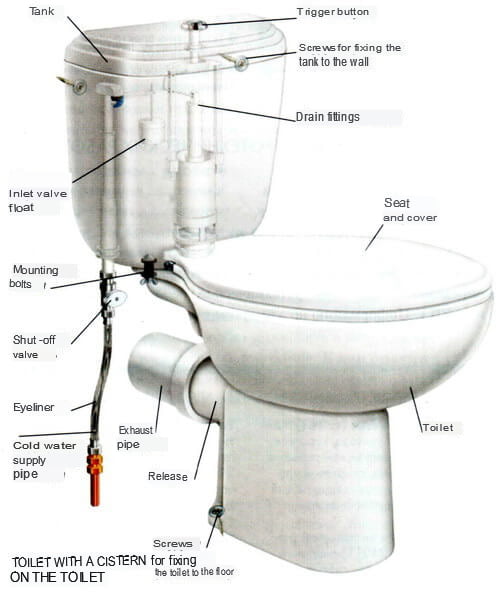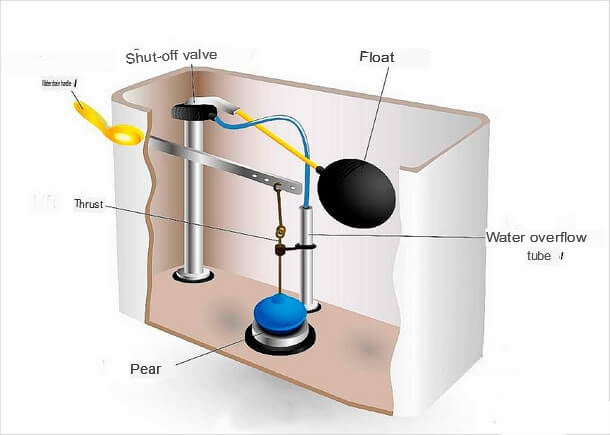A toilet breakdown is a catastrophe for all family members living in the apartment. While the toilet is functioning normally, few pay attention to it, but once this piece of plumbing goes out of order, it becomes evident that living without a toilet is possible but highly inconvenient.
Most often, the mechanism of the flush tank is what breaks down in the toilet’s structure. Repairing it is well within the capabilities of an average homeowner; you just need to learn what and how to fix. This article will help you understand the flush tank’s design and how to repair it.
How the Flush Tank Works
Before starting the tank repair, it’s essential to understand how this system operates.
The flush tank has the following structure:
Reservoir.
Button for flushing water.
Water supply valve.
Float.
Flushing device.

How the Flush Tank Works
Filling Process
Water flows into the water supply valve through a hose, which is connected to a float. When the reservoir is filled to the desired level, the float closes the valve, stopping the water supply.
Flushing Process
Pressing the button puts pressure on the flushing device, which opens the water discharge valve. When the button returns to its original position, the valve in the flushing device blocks the water discharge, and the reservoir begins to fill again. This is due to the float descending and the water supply valve opening.
As you can see, it’s all straightforward and understandable, but for some reason, this system often malfunctions.

Most Common Flush Tank Failures
The Flush Tank Doesn’t Fill with Water
There can be two reasons for this malfunction: the float getting stuck in the upper position or the valve becoming clogged or worn out.
To solve the problem, turn off the water supply and remove the tank’s lid.
Check the float’s movement by moving it up and down. If water supply doesn’t resume after reopening the valve, then the issue lies with the valve.
Disconnect the float from the valve, unscrew the nut connecting the valve and the hose, and remove the valve from the flush tank. Clean the valve thoroughly from both sides using an air pump.
Reinstall the valve, reconnect the hose and float, and turn on the water supply.
If water still doesn’t appear, it means you need to replace the worn-out valve. For safety, remove the old valve and take it to the store to ensure you buy the correct replacement valve.
Continuous Water Flow into the Toilet
This is the most common flush tank failure. The constant water leakage into the toilet can be caused by the flush mechanism of the tank failing or the gasket of the flush valve wearing out.
You can solve this problem by replacing the gasket or the entire water discharge mechanism.
To replace the gasket, unscrew the fasteners and remove the water discharge mechanism from the tank.
After replacing the old gasket with a new one, reinstall the mechanism.
In addition to these reasons, continuous water inflow into the toilet can be caused by the float getting stuck in the lower position, valve wear, float ball wear, or improper adjustment of the reservoir’s fill level. You can address all of these issues by replacing worn-out parts with new ones and adjusting them accordingly.
Water Leaking from Under the Tank
If the reservoir doesn’t have a crack, the most likely reason is that the bolts securing the tank to the toilet are not tightly fastened or the gasket positions are incorrect.
First, try to tighten the fastening bolts more firmly using a wrench.
If water continues to leak, you’ll need to replace the gaskets. To do this, drain the tank, disconnect the water supply hose from the tank, and remove any parts obstructing access to the fastening bolts. Then, replace the gaskets, making sure they are properly aligned and not twisted. Fill the tank with water to check for leaks. Reattach the removed parts, reconnect the hose, and reinstall the tank lid.
This article has covered only three of the most common flush tank breakdowns, but as practice shows, there are many more possible issues. However, once you learn to handle at least one of these breakdowns, repairing the others will become much easier.